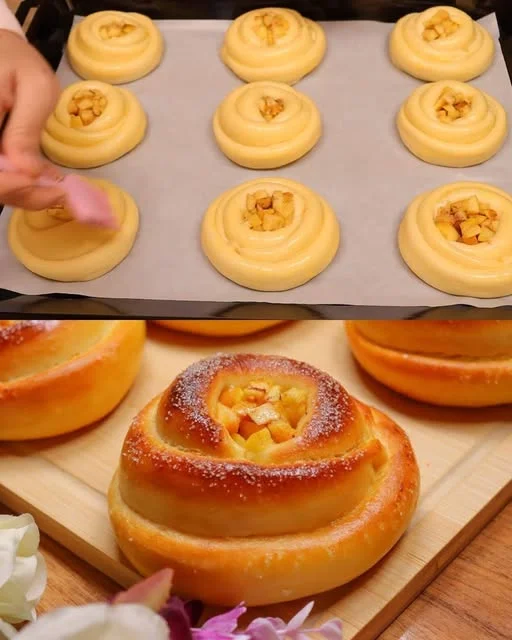It was the day after Christmas. The guests were gone, the dishes were done, and all that remained in the fridge were half-used ingredients and leftover wrapping paper. The kitchen, once buzzing with holiday energy, had gone quiet. I stood at the counter with exactly two eggs, a small bag of flour, and not much else.
I wasn’t planning to cook — certainly not to impress anyone. But the winter wind outside and the familiar hush of the post-holiday lull made me crave something warm, quick, and filling. Something that smelled like comfort.
That’s when I remembered an old trick my grandmother used to show me when I was a child. She called it “poor cakes” — a humble mix of flour, eggs, and salt, pan-fried into little golden rounds. Sometimes she added milk, sometimes not. Sometimes they were topped with jam, sometimes just eaten plain out of the pan. They weren’t fancy, but they were ours.
I made them that day, not expecting much. But as I flipped the first cake and watched it rise just slightly, browning at the edges, something clicked. The kitchen began to feel warm again. These simple, rustic skillet cakes brought the joy of the holidays back into the house — without any of the stress.
Now, I make them every year after Christmas. They’ve become a quiet tradition in my home — a reminder that sometimes the best meals come from the most ordinary things.
Why These Simple Skillet Cakes Are Worth Making Again and Again
In a world of over-the-top desserts and time-consuming meals, this recipe is a breath of fresh air. It doesn’t rely on sugar, butter, or even baking powder. It doesn’t require special tools. It’s what many would call peasant food — but I call it genius.
These skillet cakes are lightly crisp on the outside, tender on the inside, and endlessly customizable. Think of them like a cross between pancakes and flatbreads — humble in ingredients but surprisingly satisfying in flavor and texture.
Here’s why they deserve a spot in your recipe rotation:
- Made with 3–4 pantry staples
You likely already have everything you need to make them, even after a holiday grocery haul. - Quick and easy to prepare
From mixing to serving, you can make a batch in under 15 minutes. - Versatile and crowd-pleasing
Serve them sweet or savory, dressed up or down — they suit every taste. - A great way to reduce waste
Use leftover milk, jam, cheese, or even herbs to give them new life.
Ingredients
| Ingredient | Quantity |
|---|---|
| Flour | 1 bowl (~150 g) |
| Eggs | 2 |
| Milk | 50–100 ml (optional) |
| Salt | A pinch |
Directions
- In a mixing bowl, beat the eggs with a pinch of salt until well blended.
- Gradually add the flour, mixing until a thick batter forms.
- Add milk a little at a time, only if needed, to loosen the batter to a pourable consistency (similar to thick pancake batter).
- Heat a lightly oiled skillet or non-stick pan over medium heat.
- Spoon small amounts of batter into the pan to form individual cakes.
- Cook for 2–3 minutes on each side until golden brown and fully cooked through.
- Serve warm. These can be enjoyed with sweet toppings like honey or jam, or savory with cheese, herbs, or sour cream.
Nutritional Information (Per Piece – Approx. 8 Small Cakes)
| Nutrient | Amount (Approx.) |
|---|---|
| Calories | ~110 kcal |
| Carbohydrates | ~14 g |
| Protein | ~4 g |
| Fat | ~4 g |
| Saturated Fat | ~1 g |
| Fiber | ~0.5 g |
| Sodium | ~80 mg |
Serving Ideas for Every Appetite
These skillet cakes are incredibly versatile — think of them as a blank canvas ready for your favorite toppings or fillings. Here are just a few ways to serve them:
Sweet Options
- Spread with fruit preserves or jam
- Drizzle with honey or maple syrup
- Dust with powdered sugar and a squeeze of lemon
- Top with fresh berries and whipped cream
Savory Options
- Spread with cream cheese and herbs
- Top with scrambled eggs and cheese
- Serve with sour cream and smoked salmon
- Add sautéed mushrooms and garlic butter
These cakes also make great substitutes for flatbreads, wraps, or even sandwich bread in a pinch. Cut them into wedges, use them as a base for mini pizzas, or pack them as an easy travel snack.
Variations to Try
Though the base recipe is as simple as it gets, there are plenty of ways to make it your own:
Add Herbs or Spices
Mix fresh or dried herbs (like parsley, dill, oregano) into the batter for a savory twist. A pinch of black pepper, cumin, or paprika adds depth.
Cheese It Up
Fold in shredded cheese like cheddar, mozzarella, or parmesan. It will melt slightly and create golden cheesy spots as the cakes cook.
Make It Fluffier
Add ½ teaspoon of baking powder for a slightly lighter, airier texture — though traditional versions often skip it.
Make It Dairy-Free
Skip the milk entirely (as the recipe allows) or use plant-based milk like oat, almond, or soy. The result is still beautifully tender.
Gluten-Free Option
Use a gluten-free flour blend. The texture might be slightly different, but the results will still be delicious.
Frequently Asked Questions
Can I make these without milk?
Yes! Milk is entirely optional in this recipe. It helps thin the batter slightly and adds a touch of richness, but water works just fine — or you can skip it entirely for a thicker, more rustic dough.
What kind of flour works best?
All-purpose flour is ideal for a balanced texture. You can experiment with whole wheat flour for more fiber and a heartier flavor, but you may need to add a little extra liquid.
Do I need to use oil or butter in the pan?
Yes, a light amount of oil or butter prevents sticking and helps give the cakes a beautiful golden crust. Use neutral oils like sunflower, canola, or a knob of butter for flavor.
How thick should the batter be?
The consistency should be thicker than pancake batter but still scoopable. Think: somewhere between muffin batter and soft dough. You can adjust with milk as needed.
How long do they keep?
These cakes are best served fresh, but they keep well in the fridge for 2–3 days. Reheat in a dry skillet or toaster oven to restore their crisp edges.
Can I freeze them?
Yes. Let them cool completely, then freeze in a single layer before storing in an airtight container. To reheat, toast them directly from frozen in a pan or oven.
Can I make the batter in advance?
You can mix the batter and let it rest in the fridge for a few hours. Bring it back to room temperature and give it a quick stir before cooking.
Tips for Success
- Whisk the eggs well before adding the flour for a smoother batter.
- Don’t overcrowd the pan — give the cakes space to spread and flip easily.
- Cook on medium heat — too high, and they’ll brown before the inside cooks; too low, and they’ll turn out pale and doughy.
- Wipe the pan between batches if needed to avoid burnt bits or sticking.
Conclusion: A Post-Holiday Tradition Worth Keeping
Sometimes, the recipes we remember most aren’t the grandest ones. They’re not frosted, filled, or flambéed. They’re the ones we turn to when things quiet down — when the guests are gone, the fridge is half-empty, and we just want something warm and comforting in our hands.
These simple skillet cakes may not win awards, but they win hearts. They remind us that cooking doesn’t have to be complicated to be meaningful. With just flour, eggs, and salt, you can make something that feels like a small victory — something that brings you back to center after the whirlwind of the holidays.
So when December turns into January and the world slows down again, try making these. Let the sizzle of batter in the pan warm your kitchen. Let the scent of golden crust carry you back to childhood, or forward to something new.
Few people know this trick, but once you do — once you make these — they just might become your new favorite way to start the year.


